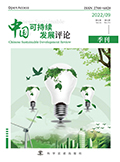

城镇用地和耕地是受人为活动影响最为剧烈的两种土地利用类型, 是联合国可持续发展目标SDG11 (可持续城市和社区) 和SDG2 (零饥饿) 的承载体。中国作为一个快速发展的经济体, 近年来城镇化进程加快, 城镇用地扩展与耕地保护矛盾突出, 反映出SDG11与SDG2之间的交互与权衡。本文基于中国土地利用变化遥感监测数据和2030年城镇用地扩展预测数据, 采用GIS空间分析方法和指标分析法, 从中国国家尺度和粮食主产区两个层次, 分析可持续发展目标提出元年 (2015年) 前后, 城镇扩展对耕地占用的潜在时空特征差异。研究发现: ①相比2000—2015年, 预测的2015—2030年中国城镇用地扩展对耕地的占用将会明显减缓, 降幅为59%~65%; 长江中下游地区的城镇扩展导致耕地面积减少量最多, 东北区降幅最大, 不同规模城镇Ⅰ类城镇降幅最大。②与全国平均状况相比, 未来粮食主产区中城镇扩展给耕地面积造成的影响预估将愈发严重, 其中黄淮海区、西南区、黄土高原区的粮食主产区, 还有粮食主产区里的Ⅰ类、Ⅳ类城镇表现得最为显著。③不同共享社会经济路径中, 可持续发展情景对耕地资源的保护未见成效, 城镇扩展占用耕地现象较为严重, 且耕地对城镇扩展的贡献最大, 因而综合考虑粮食安全的情况下应当对可持续发展情景进行适当修正。本研究可为中国新型城镇化背景下的耕地可持续化发展提供支撑。
Urban land and cropland are two land-use types most significantly affected by human activities, serving as critical indicators for the United Nations’ SDG11 (Sustainable Cities and Communities) and SDG2 (Zero Hunger) . As a rapidly developing major economy, China has experienced accelerated urbanization in recent years, resulting in intensified conflicts between urban expansion and cropland protection, thereby reflecting the trade-offs between SDG11 and SDG2. Using remote sensing-based change data and projections of urban land expansion by 2030, this study applies GIS spatial analysis and indicator-based methods to explore the spatial and temporal characteristics of cropland occupation by urban expansion around the baseline year 2015, both at the national level and within major grain producing region. The study finds that: 1) The most significant cropland loss due to urban expansion is projected in the middle and lower reaches of the Yangtze River, while the Northeast shows the highest rate of decline. Among cities of different sizes, Type-I municipalities exhibit the greatest reduction. 2) In contrast to the national trend, urban expansion in major grain-producing areas is projected to exert an increasingly severe impact on cropland, particularly in the Huang-Huai-Hai Plain, the Southwest, and the Loess Plateau. Type-I and Type-IV municipalities within these regions show the most pronounced effects. 3) Under various Shared Socioeconomic Pathways, the sustainable development scenario has not effectively curbed cropland loss. Urban expansion continues to encroach upon cropland substantially, with cropland being the primary contributor to land conversion. These findings suggest that sustainable development scenarios should be adjusted to better incorporate food security concerns.